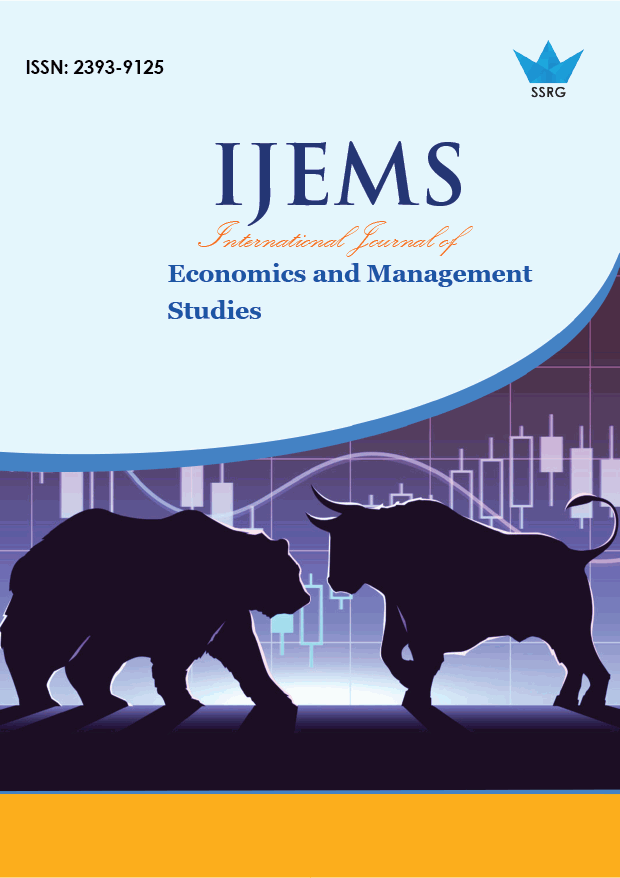Discrimination against ethnic minoritiesin Britain: whydid racial discrimination increasefrom 2010 to 2015?

| International Journal of Economics and Management Studies |
| © 2015 by SSRG - IJEMS Journal |
| Volume 2 Issue 3 |
| Year of Publication : 2015 |
| Authors : John Simister, HannahLouise Holmes |
How to Cite?
John Simister, HannahLouise Holmes, "Discrimination against ethnic minoritiesin Britain: whydid racial discrimination increasefrom 2010 to 2015?," SSRG International Journal of Economics and Management Studies, vol. 2, no. 3, pp. 16-24, 2015. Crossref, https://doi.org/10.14445/23939125/IJEMS-V2I2P104
Abstract:
This paper investigates the extent to which ethnic minorities face discrimination in the British labour market. It uses data from ‘Labour Force Survey’ and ‘British Social Attitudes’ surveys, from 1983 to 2014. Several kinds of discrimination are assessed – including the chance of finding paid work, and wage-rates for employees. This paper considers how far Britain’s labour force is ‘meritocratic’ (i.e.unprejudiced).This paper considers the possibility suggested by Charteris-Black(2006) that Conservative governments may have increased racial prejudice; empirical evidence from 1979 to 1997, and from 2010 to 2015, are used to assess this question.
Keywords:
Britain, discrimination, labour market, racial prejudice
References:
[1] Aston J., Hill D. &Tackey N.D. (2006), ‘The experience of claimantsin race discriminationemployment tribunal cases’, Employment relations research series 55, Department of Trade & Industry (UK government): London.
[2] Blinder S., Ford R. &Ivarsflaten E. (2013), ‘The better angels of our nature: how the antiprejudice norm affects policy and party preference in Great Britain and Germany’, American Journal of Political Science 57(4): 841-57.
[3] Bradley S. &Lenton P. (2007), ‘Dropping out of post-compulsory education in the UK: an analysis of determinants and outcomes’, Journal of Population Economics 20(2): 299-328.
[4] Butler D. & Stokes D. (1974), Political change in Britain: the evolution of electoral choice, Macmillan: London.
[5] Charteris-Black J. (2006), ‘Britain as a container: immigration metaphors in the 2005 election campaign’, Discourse & Society 17(5): 563-81.
[6] Clancy S. (2012), ‘Equal Britain? 1 in 3 Brits admit they are racist’, http://news.onepoll.com/brits-admits-racist/ downloaded 14th February 2015.
[7] Communities and Local Government (2010), Tackling race inequality: a statement on race, www.communities.gov.uk/documents/communities/pdf/1432344.pdf accessed 10th February 2010.
[8] Cooper A. & Perkins C. (2015), ‘Mobile borders/bordering mobilities: status functions, contemporary state bordering practices and implications for resistance and intervention’, pages 14 – 31 in Kinnvall C. &Svensson T. (eds.), Governing borders and security: the politics of connectivity and dispersal, Routledge: Abingdon.
[9] Dorey P. (2007), ‘A new direction or another false dawn? David Cameron and the crisis of British Conservatism’, British Politics 2: 137-66.
[10] Guryan& Charles (2013), ‘Taste-based or statistical discrimination: the economics of discrimination returns to its roots’, Economic Journal 123: F417-32.
[11] Haagsma R. (1998), “Statistical discrimination in the labour market: an efficient vice?”De Economist, 146(2): 321-45.
[12] Hansen R. (2000), Citizenship and immigration in postwar Britain, OUP: Oxford.
[13] Harford T. (2010), The logic of life, Hachette: London.
[14] Heslin P.A., Bell M.P. & Fletcher P.O. (2012), ‘The devil without and within: A conceptual model of social cognitive processes whereby discrimination leads stigmatized minorities to become discouraged workers’, Journal of Organizational Behavior 33(6): 840-62.
[15] Holzer H.J. &Ihlanfeldt K.R. (1998), “Customer discrimination and employment outcomes for minority workers”, Quarterly Journal of Economics, 113(3): 835-67.
[16] Home Office (2008), ‘The Economic Impact of Immigration’, Cm 7414, The Stationery Office: London.
[17] Ichino P. (1998), “The labour market: a lawyer’s view of economic arguments”, International Labour Review, 137:3, pp. 299-311.
[18] Marangozov R. (2014), ‘Labour migration from the EU in hard times’, Employment Studies 19(1). www.employment-studies.co.uk/newsletters/employment-studies#issue19 downloaded 21st February 2015.
[19] Maskin E. &Tirole J. (1990), “The Principal-Agent relationship with an informed Principal: the case of private values”, Econometrica, 58 (2): 379-409.
[20] Mason P.L. (1999), “Male interracial wage differentials: competing explanations”, Cambridge Journal of Economics, 23:3, 261- 99.
[21] cCrudden C., Smith D.J. & Brown, C. (1991), Racial justice at work: the enforcement of the Race Relations Act 1976 in employment, Policy Studies Institute: London.
[22] McNabb R. &Psacharopoulos G. (1981), “Racial earnings in the U.K.”, Oxford Economic Papers, 33:3, pp. 413-25.
[23] Meager N. (2014), ‘IES Viewpoint: Productivity puzzles and poor performance’, Employment Studies 20(2), www.employment-studies.co.uk/newsletters/employment-studies#issue20 downloaded 21st February 2015.
[24] Modood T. (1997), “Employment”, in Modood, T., Berthoud, R., Lakey, J., Nazroo, J., Smith, P., Virdee, S. &Beishon, S. (eds.), Ethnic Minorities in Britain: diversity and disadvantage, Policy Studies Institute: London.
[25] NatCen (2014), ‘Sample design’, http://bsa-31.natcen.ac.uk/read-the-report/technical-details/sample-design.aspx downloaded 22nd February 2015.
[26] Nord S. & Ting Y. (1994), “Discrimination and the unemployment durations of white and black males”, Applied Economics, 26(10): 969-79.
[27] Rhodes E. & Braham P. (1981), “Black workers in Britain: from full employment to recession”, in Braham, P., Rhodes, E. &Pearn, M. (eds.), Discrimination and disadvantage in employment: the experience of black workers, Harper & Row: London.
[28] Rodgers W.M. (ed.) (2006), Handbook on the economics of discrimination, Edward Elgar: Northampton.
[29] Schelling T. (1971), ‘Dynamic models of segregation’, Journal of Mathematical Sociology 1: 143-86.
[30] Simister J. (2000), ‘Long-term trends in wage discrimination against ethnic minorities: USA and UK’, Journal of Interdisciplinary Economics 11(3-4): 341-57.
[31] Simister J. (2011), ‘Elitism and meritocracy in UK universities: the UK needs investment in its labour force’, Higher Education Quarterly 65(2): 113-44.
[32] Solomos J. (1989), “The politics of anti-discrimination: planned social reform or symbolic politics?” in Jenkins, R. &Solomos, J. (eds.), Racism and equal opportunity policies in the 1980s, CUP: Cambridge.
[33] Stewart M.B. (1983), “Racial discrimination and occupational attainment in Britain”, Economic Journal, 93:3, pp. 521-41.
[34] Taylor M. &Rampino T. (2014), ‘Educational aspirations and attitudes over the business cycle’, Economica 81: 649-73.
[35] Thwaites L. (2014), ‘The British equality framework is incapable of achieving equality in the workforce’, North East Law Review 2(1): 137-68. https://research.ncl.ac.uk/nelr/thereview/volumetwo/
[36] Wainwright D. (1979), Discrimination in employment: a guide to equal opportunity, Associated Business Press: London.
[37] Webber F. (2014), ‘Extending immigration policing and exclusion in the UK’,Race & Class 55(3): 86-92.

 10.14445/23939125/IJEMS-V2I2P104
10.14445/23939125/IJEMS-V2I2P104